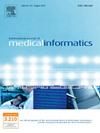Translating the machine; An assessment of clinician understanding of ophthalmological artificial intelligence outputs
IF 3.7
2区 医学
Q2 COMPUTER SCIENCE, INFORMATION SYSTEMS
International Journal of Medical Informatics
Pub Date : 2025-05-06
DOI:10.1016/j.ijmedinf.2025.105958
引用次数: 0
Abstract
Introduction
Advances in artificial intelligence offer the promise of automated analysis of optical coherence tomography (OCT) scans to detect ocular complications from anticancer drug therapy. To explore how such AI outputs are interpreted in clinical settings, we conducted a survey-based interview study with 27 clinicians —comprising 10 ophthalmic specialists, 10 ophthalmic practitioners, and 7 oncologists. Participants were first introduced to core AI concepts and realistic clinical scenarios, then asked to assess AI-generated OCT analyses using standardized Likert-scale questions, allowing us to gauge their understanding, trust, and readiness to integrate AI into practice.
Methods
We developed a questionnaire through literature review and consultations with ophthalmologists, computer scientists, and AI researchers. A single investigator interviewed 27 clinicians across three specialties and transcribed their responses. Data were summarized as medians (ranges) and compared with Mann–Whitney U tests (α = 0.05).
Results
We noted important differences in the impact of various explainability methods on trust, depending on the clinical or AI scenario nature and the staff expertise. Explanations of AI outputs increased trust in the AI algorithm when outputs simply reflected ground truth expert opinion. When clinical scenarios were complex with incorrect AI outcomes, a mixed response to explainability led to correctly reduced trust in experienced clinicians but mixed feedback amongst less experienced clinicians. All clinicians had a general consensus on lack of current knowledge in interacting with AI and desire more training.
Conclusions
Clinicians’ trust in AI algorithms are affected by explainability methods and factors, including AI’s performance, personal judgments and clinical experience. The development of clinical AI systems should consider the above and these responses ideally be factored into real-world assessments. Use of this study’s findings could help improve the real world validity of medical AI systems by enhancing the human–computer interactions, with preferred explainability techniques tailored to specific situations.

翻译机器;临床医生对眼科人工智能输出的理解程度评估
人工智能的进步为光学相干断层扫描(OCT)的自动分析提供了希望,以检测抗癌药物治疗引起的眼部并发症。为了探索如何在临床环境中解释这些人工智能输出,我们对27名临床医生进行了基于调查的访谈研究,其中包括10名眼科专家、10名眼科从业者和7名肿瘤学家。参与者首先被介绍了核心人工智能概念和现实的临床场景,然后被要求使用标准化的李克特量表问题评估人工智能生成的OCT分析,使我们能够衡量他们的理解、信任和将人工智能整合到实践中的准备情况。方法通过查阅文献并咨询眼科医生、计算机科学家和人工智能研究人员,编制问卷。一名研究者采访了来自三个专业的27名临床医生,并记录了他们的回答。数据汇总为中位数(极差),采用Mann-Whitney U检验比较(α = 0.05)。结果我们注意到,根据临床或人工智能场景的性质以及工作人员的专业知识,各种可解释性方法对信任的影响存在重要差异。对AI输出的解释增加了对AI算法的信任,当输出仅仅反映了基本事实的专家意见。当临床场景复杂且人工智能结果不正确时,对可解释性的混合反应导致对经验丰富的临床医生的信任降低,但在经验不足的临床医生中反馈不一。所有临床医生普遍认为缺乏与人工智能互动的现有知识,并希望获得更多培训。结论临床医生对人工智能算法的信任程度受到人工智能性能、个人判断和临床经验等可解释性方法和因素的影响。临床人工智能系统的开发应考虑上述因素,理想情况下,这些反应应纳入现实世界的评估。利用这项研究的发现,可以通过增强人机交互,以及针对特定情况量身定制的可解释性技术,帮助提高医疗人工智能系统在现实世界中的有效性。
本文章由计算机程序翻译,如有差异,请以英文原文为准。
求助全文
约1分钟内获得全文
求助全文
来源期刊

International Journal of Medical Informatics
医学-计算机:信息系统
CiteScore
8.90
自引率
4.10%
发文量
217
审稿时长
42 days
期刊介绍:
International Journal of Medical Informatics provides an international medium for dissemination of original results and interpretative reviews concerning the field of medical informatics. The Journal emphasizes the evaluation of systems in healthcare settings.
The scope of journal covers:
Information systems, including national or international registration systems, hospital information systems, departmental and/or physician''s office systems, document handling systems, electronic medical record systems, standardization, systems integration etc.;
Computer-aided medical decision support systems using heuristic, algorithmic and/or statistical methods as exemplified in decision theory, protocol development, artificial intelligence, etc.
Educational computer based programs pertaining to medical informatics or medicine in general;
Organizational, economic, social, clinical impact, ethical and cost-benefit aspects of IT applications in health care.
 求助内容:
求助内容: 应助结果提醒方式:
应助结果提醒方式:


